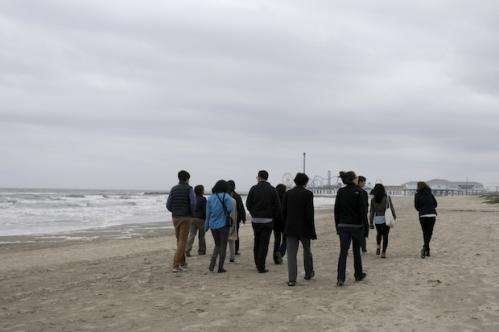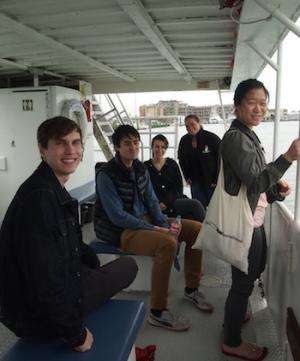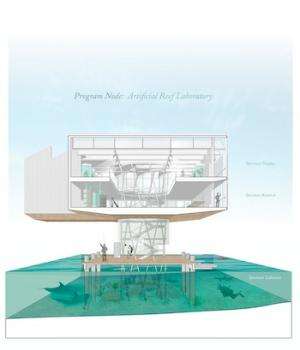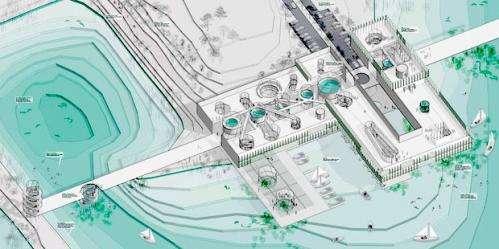Going deep for dolphins

Celebrated architect Jeanne Gang challenged her Rice University School of Architecture (RSA) students to decode a problem she characterized as "beyond complex."
Gang, a Chicago-based architect and MacArthur Foundation fellow profiled in the current New Yorker magazine, is working with the National Aquarium in Baltimore to explore how design can help it achieve its conservation mission. One component was to evaluate options for life beyond the aquarium for its resident dolphins where they could "retire" to a protected habitat closer to nature.
As mentioned in the profile, she also spent the spring as a visiting professor at RSA, where she enlisted her students to help define the parameters of a difficult task: to create a marine mammal rescue center and a dolphin sanctuary on the Gulf Coast of Texas.
In the process, she also encouraged students to go deep as they researched the needs of the staff, the volunteers, the visitors and the dolphins and the possibilities and problems the animals might face in a coastal habitat.
"The National Aquarium is aware of emerging science that shows the difficulties cetaceans are having in captivity," Gang said during a midterm visit to Rice. "Public attitudes are shifting away from wanting to see dolphins perform." The aquarium had presented dolphin shows in a purpose-built auditorium until halting them in 2012.
"We're helping them strategize about what to do with their current facilities as well as helping them think through their role as an aquarium of the future," Gang said. "They're trying to move toward being an effective conservation organization that happens to have an aquarium."
Gang is best known for the undulating Chicago skyscraper known as Aqua, the tallest in the world (859 feet), designed by a woman-led firm, Studio Gang Architects. Its flowing design hinted at her interest in the environment and helped lead to projects that have become close to her heart, including an ongoing investigation of the Chicago River, for which her firm designed a unique boathouse, and the sanctuary project itself.
Gang connected to RSA through Dean Sarah Whiting, with whom she worked at Rem Koolhaas' Office for Metropolitan Architecture in Rotterdam. "Jeanne is what I'd call an 'activist architect'," Whiting said. "She's passionate about environmental issues and is dedicated to finding ways that architecture can play a role. As an activist, as well as being one of the most successful women architects practicing today, she provides an ideal role model for our students."
As a way to enhance her own research, Gang steered the Rice studio toward marine spatial planning, a discipline that to date has not required architects. "When I first heard the term a year ago, I said, 'Why aren't architects leading this?' We began our own research at Studio Gang, and I wanted to extend that research into my semester of teaching at Rice."

To get a sense of what's at stake, Gang and her students spent part of spring break on a trip to Corpus Christi, Texas, and the Flower Garden Banks National Marine Sanctuary, operated by the National Oceanic and Atmospheric Administration. They studied the protected coral that supports the bottom of the food chain and saw dolphins in their natural habitat. For contrast, the Texas State Aquarium welcomed them to view their operations, as well as the aquarium's dolphin show. "The aquarium was very helpful to our studio," Gang said. "A significant part of our visit was with their marine mammal rescue program that does a great job of caring for stranded and injured animals."
Marine sanctuaries benefit commercial uses of the ocean, especially fisheries, she said. "There are interconnected needs and desires and mutually beneficial relationships that could occur through marine spatial planning. However, no architects have ever been involved with it before – or urban designers, for that matter."
She argued such planning is "essentially similar to doing urban design," with one essential difference. "It's harder because it has a third dimension: depth. But in terms of how our brains work, it's a natural fit. We organize things. We organize space both three-dimensionally and in (two-dimensional) plan."
That's where her students' minds were in mid-March when they presented their views of how the Gulf of Mexico coast could be angled toward the kind of sanctuary Gang may ultimately design, one that would contain and protect dolphins but still give them a sense of life in the open ocean. Students drew on freely available geographic information system data to define potential sites that would not disrupt shipping lanes and other forms of unwanted human contact but still offer shelter from direct hits by hurricanes.
"Remember, we have to get people there, too. The dolphins are still in pens, so there has to be feeding component, a health care component, for the dolphin that's never going to go wild," Gang said.
"In the first part of the course we researched the possibility of designing a dolphin sanctuary in Texas and what that would entail," said new Rice alumna Weijia Song '14. "The second half of the course focused on taking that research and developing a concept for the sanctuary." The proposals had to include public access, which meant designing a land-based component as well as a marine research center, she said.
Most of the 10 students presented concepts for sanctuaries near Corpus Christi, while others chose Galveston and one picked a site straddling the border with Mexico. Song's idea would take a portion of Redfish Bay, a shipping channel between the small cities of Port Aransas and Aransas Pass. "My argument was to reroute the shipping lanes in that area and to create a marine pass for dolphins and fish life," she said.
Another, by Michael Matthews '14, would reclaim a part of the busy Houston Ship Channel as a sanctuary. "Even though Galveston Bay has been dredged, dolphins rely on tides that move through the mouth of the Houston Ship Channel for feeding, creating an overlap between heavy industry and one of the largest bottlenose dolphin populations in Texas," he said. His facility would be built on an abandoned port and offer opportunities for the public to view both protected and wild dolphins.

Song said students were required to design 60,000 square feet of living space/display area for the dolphins and 40,000 square feet for the back-of-house support system. "In a lot of aquariums, the back-of-house, the life support that functions to keep these animals alive, is almost equal to the display space. We had to think about that as well.
"It was interesting to learn about the sheer amount of technology that was needed to support these animals, to keep them alive for us to see them," she said.
"What was interesting about the studio was that since there was no single precedent and such a range of relevant research, the students each had to come up with their own particular angle," said Anika Schwarzwald, who earned her master's in architecture at Princeton last year and served as Gang's assistant at Rice. "In the end, everyone had a unique approach to the problem, which was wonderful to see."
The students had to consider all aspects of marine life, including commercial and political interests, Gang said. "Oil companies and fisheries don't really want any kind of legislation telling them what they can or cannot do," she said. "The concept of marine special planning is to get all these people to the table and try to do something that's mutually beneficial."

All of this research will help Gang as she organizes a summit for late May to discuss ways to transform not only the lives of the National Aquarium's dolphins but the aquarium itself.
Gang said she hoped she left her students with a new appreciation for the Texas coast and its creatures. "Even though this was a hypothetical exercise and might not be the place where the work I'm doing with aquaria can be applied, the studio gave us a chance to learn more about the unique ecology in Texas and how architecture can play a role in its future. I learned a lot by seeing this place through my students' eyes."
Provided by Rice University